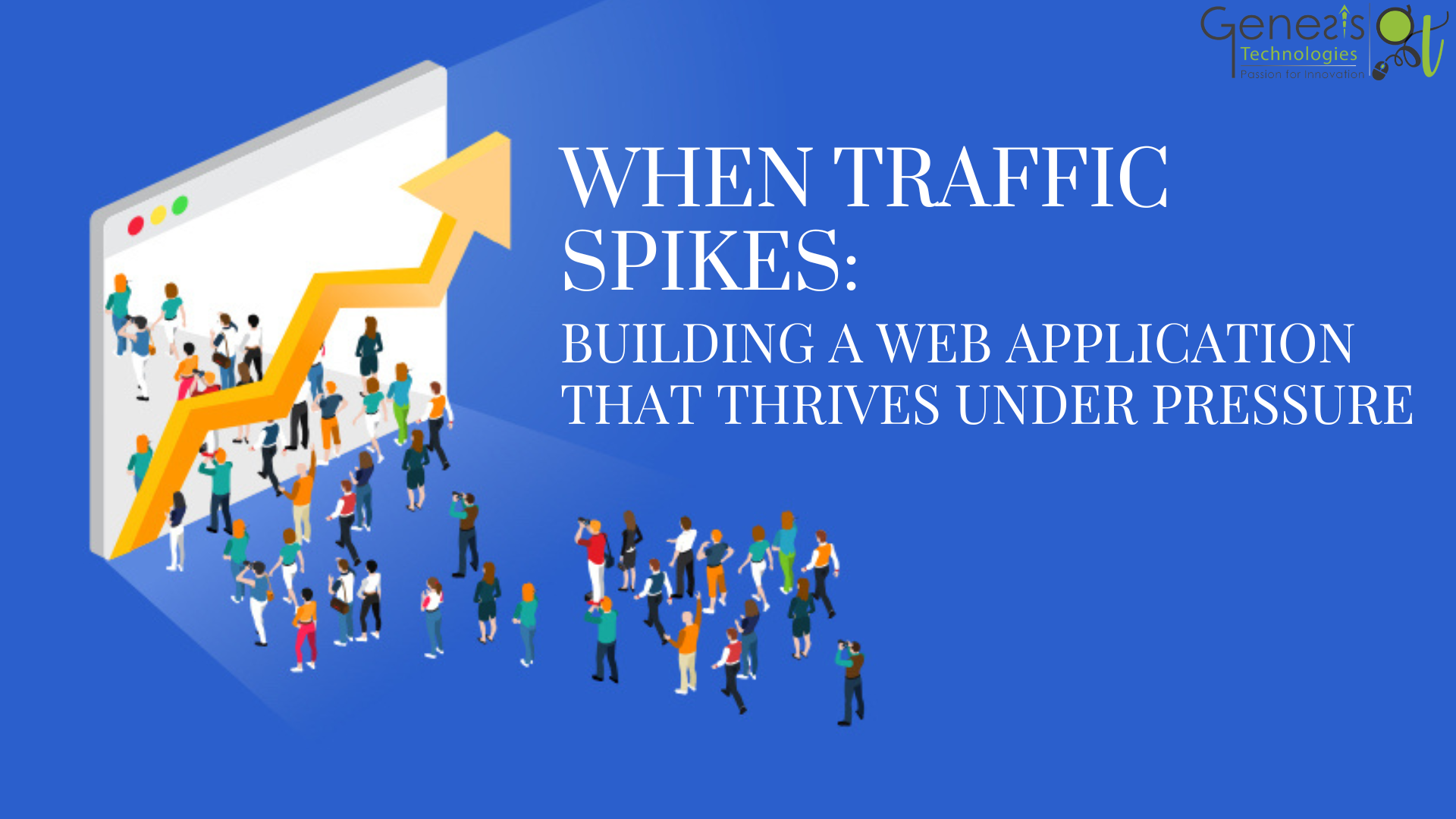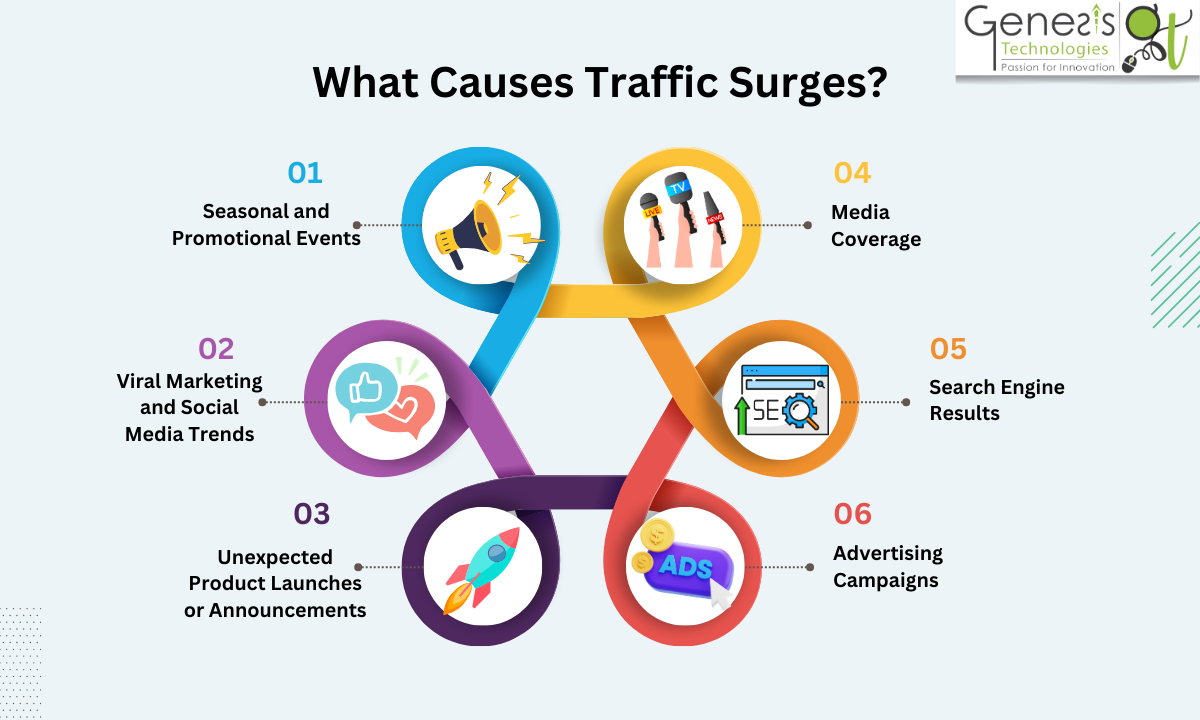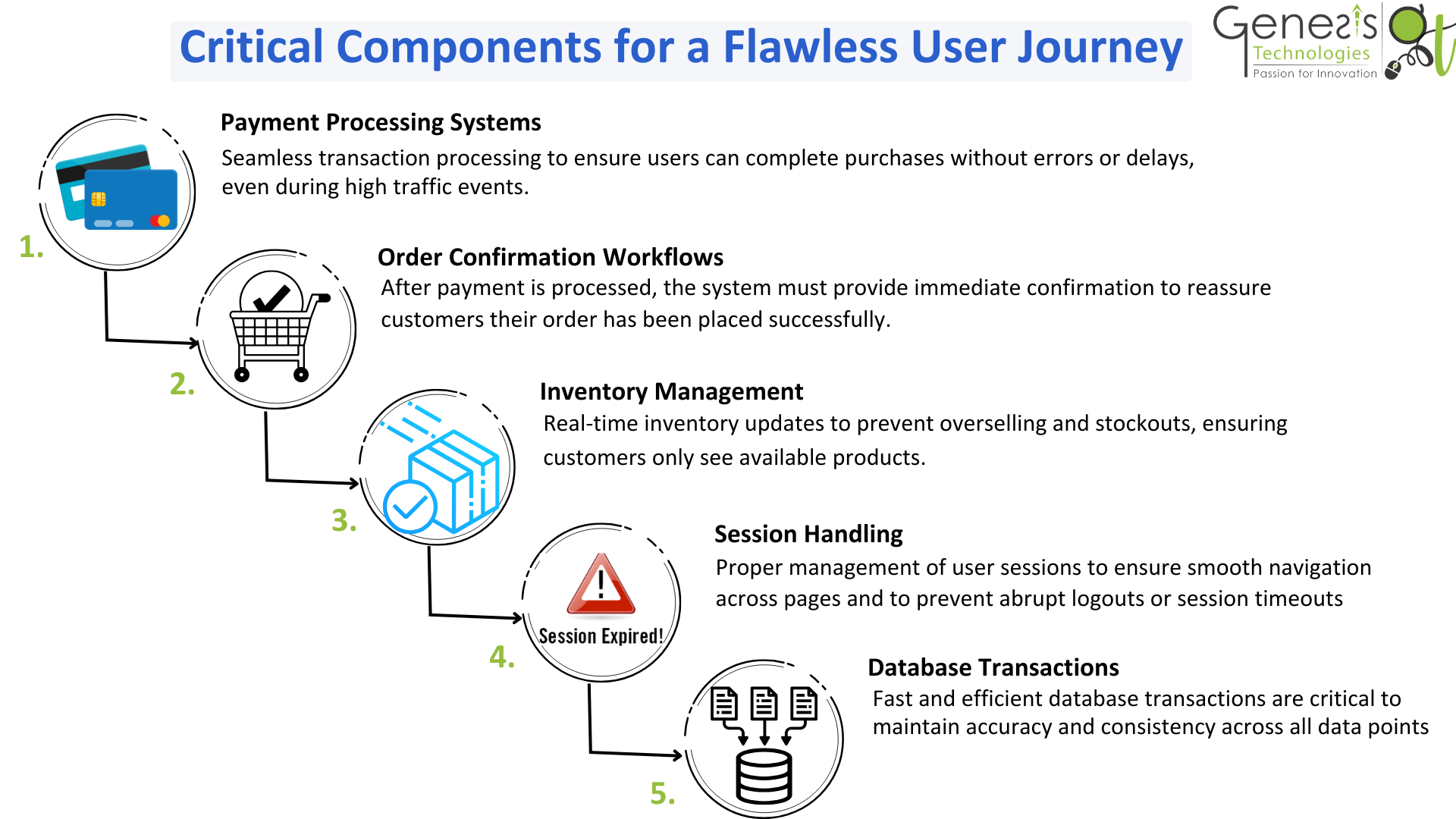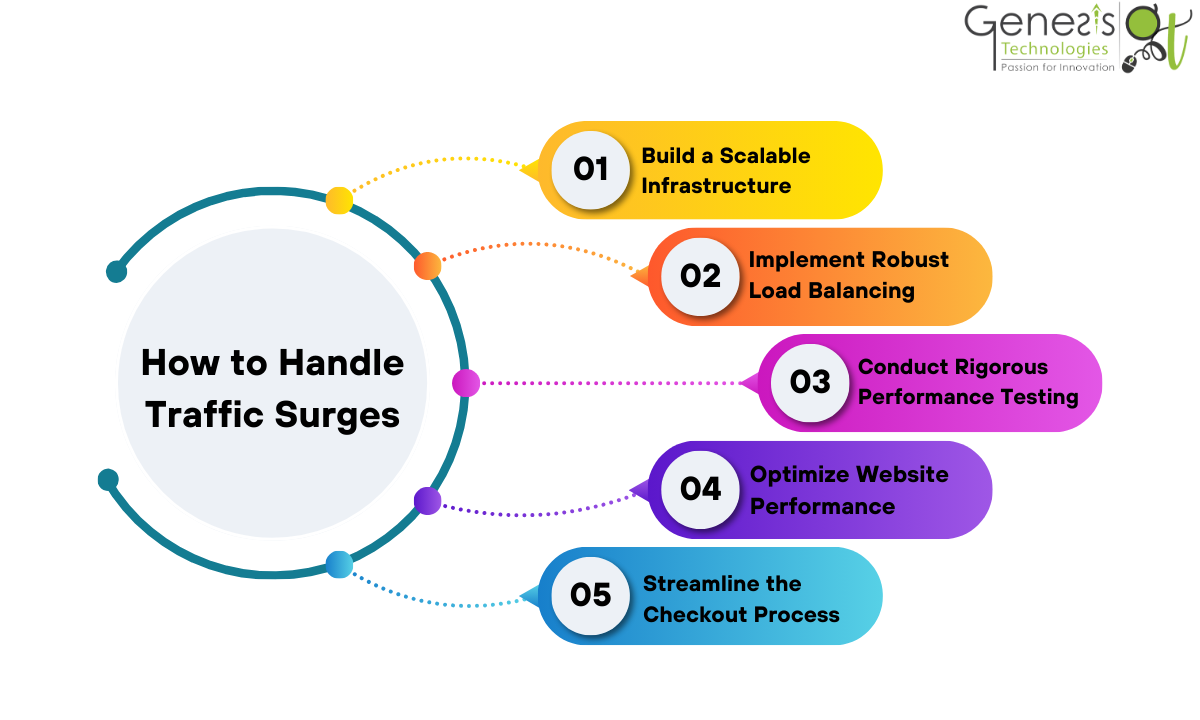When Traffic Spikes: Building A Web Application That Thrives Under Pressure

Introduction
Imagine an e-commerce website experiencing a massive influx of customers during a Black Friday sale, a golden opportunity for a revenue surge. But as a customer proceeds to checkout, they encounter a dreaded 404 Error Message. Frustrated, they abandon their cart and switch to a competitor's site. The culprit? The website's inability to handle sudden traffic spikes.
In today’s digital-first world, website performance is not just a luxury—it’s a necessity. High-traffic events like Black Friday, Diwali sales, or viral moments put websites to the ultimate test. How your site performs during these peaks can determine the success or failure of your business.
In this blog, we’ll explore the causes of traffic surges, the risks they pose to businesses, and practical measures you can implement to ensure your website thrives under pressure.
What Causes Traffic Surges?

Traffic surges on e-commerce websites can be triggered by a variety of factors, often occurring unexpectedly. Understanding these causes is essential for businesses to prepare their platforms for the sudden influx of visitors. Here are some of the key reasons why traffic spikes occur:
-
Seasonal and Promotional Events
One of the most common causes of traffic surges is seasonal shopping events like Black Friday, Cyber Monday, Diwali, Christmas, and other major sales periods. During these times, consumers flock to online stores looking for deals and discounts, leading to massive traffic spikes.
-
Viral Marketing and Social Media Trends
With the rise of social media platforms, a single viral post, influencer endorsement, or trending hashtag can send a flood of traffic to your website.
-
Unexpected Product Launches or Announcements
The launch of a new product or a major company announcement often creates a buzz, which can result in increased online traffic. Customers who are eager to try out the new offering or learn more about it will flood the website.
-
Media Coverage
Positive media coverage in mainstream publications, news outlets, or blogs can lead to sudden and significant traffic increases.
-
Search Engine Results
A boost in search engine rankings for high-volume keywords or being featured in Google’s top results can cause a significant surge in organic traffic. This can happen as a result of successful SEO strategies or algorithm updates, where your website suddenly becomes more visible to users searching for related products or services.
-
Advertising Campaigns
Paid ads, especially those run across Google, Facebook, or other digital platforms, can drive an influx of visitors to your e-commerce site. Campaigns targeting specific demographics or geographic regions often trigger spikes in website traffic, especially when they coincide with time-sensitive promotions or special offers.
The Hidden Costs of Website Downtime
When traffic surges, the consequences are significant. Gartner research reveals that IT downtime costs an average of $5,600 per minute, equating to over $300,000 per hour. The impact of downtime extends far beyond immediate financial loss, including:
- Immediate Revenue Loss: Customers unable to complete transactions are lost sales.
- Damage to Brand Reputation: Negative experiences can take months or even years to recover from.
- Erosion of Customer Trust: Future purchasing decisions and brand loyalty are deeply affected.
- Operational Costs: Recovering from downtime isn’t cheap. Businesses may need to pay for emergency support, infrastructure upgrades, or compensation for affected customers.
Imagine this scenario: a customer carefully selects items and fills their cart, only to encounter errors during checkout. This frustration leads to cart abandonment—and more dangerously, to brand abandonment. The negative experience is likely to be shared, further eroding trust.
Understanding Critical Paths
In any application, certain paths are critical to delivering a seamless user experience. In e-commerce, the checkout process is paramount. The Baymard Institute reports that nearly 70% of online carts are abandoned, with technical issues being a major contributor.
To ensure a flawless user experience, every component along this critical journey must perform flawlessly under pressure, including:
- Payment processing systems
- Order confirmation workflows
- Inventory management
- Session handling
- Database transactions

Beyond checkout, other elements—such as product search capabilities, filtering systems, and page load times—play a crucial role in conversion. When these systems falter, customers will quickly migrate to competitors.
Building for Resilience
Creating a robust, resilient application requires a comprehensive approach. Here’s how you can ensure your platform performs under pressure:

-
Build a Scalable Infrastructure
The foundation of a resilient e-commerce platform is its infrastructure. When traffic surges unexpectedly, traditional servers often fail to scale, resulting in downtime or poor performance. To ensure your platform remains operational, it’s crucial to adopt scalable infrastructure solutions.
- Cloud-Based Solutions: Cloud platforms like AWS, Google Cloud, and Microsoft Azure provide dynamic auto-scaling features that can adjust resources in real time. When your website experiences a surge, these platforms automatically allocate more resources to meet the demand, ensuring consistent performance.
- Auto-Scaling Capabilities: By using auto-scaling, businesses can prevent performance degradation or downtime during high-traffic events like sales or product launches. This feature ensures that additional server capacity is added without requiring manual intervention.
- Content Delivery Networks (CDNs): Implementing a CDN such as Cloudflare or Akamai helps distribute your website’s content across global data centers. By caching static assets (images, CSS files, etc.) close to your users, CDNs reduce the strain on your primary servers, minimize latency, and ensure faster page load times during peak periods.
- Global Reach with CDNs: CDNs also improve your website's ability to handle high global traffic, as they reduce the distance between users and the server, ensuring a faster, smoother experience.
-
Implement Robust Load Balancing
To distribute incoming traffic efficiently and ensure your website’s stability during high traffic, load balancing is essential. It helps prevent any single server from becoming overwhelmed, ensuring that users experience minimal disruption.
- Even Distribution of Traffic: Load balancing works by routing incoming traffic to multiple servers, distributing the load evenly across the infrastructure. This reduces the risk of server overload and ensures stable performance, even during unexpected surges.
- Real-Time Monitoring: Modern load balancers monitor the health of your servers in real-time. If one server becomes slow or unresponsive, the load balancer will reroute traffic to another healthy server, ensuring a seamless user experience.
- Redundancy for Reliability: For enhanced reliability, businesses should deploy backup servers. These servers act as failover solutions, stepping in seamlessly if the primary server fails. This redundancy minimizes downtime and ensures your platform remains operational during critical events, even if something goes wrong.
- Increased Reliability During Peak Times: Redundant load balancing ensures that your e-commerce platform can handle extreme traffic volumes without performance hiccups, making it ideal for major sales events like Black Friday and the holiday seasons.
-
Conduct Rigorous Performance Testing
One of the best ways to prepare for traffic surges is to test your website’s performance. By simulating high-traffic conditions, businesses can uncover potential vulnerabilities before they become major issues during peak times.
- Load Testing: Load testing evaluates how your website performs under expected traffic volumes. This test helps identify the capacity of your servers and ensures they can handle a certain number of visitors at once without affecting performance.
- Stress Testing: Stress testing pushes your platform beyond its expected limits to identify its breaking points. This test can help uncover weaknesses in your infrastructure, such as slow database queries, poor server configurations, or unoptimized code, which could cause failures during unexpected traffic surges.
- Identifying Bottlenecks: Combining load and stress tests allows you to identify potential bottlenecks in your infrastructure, whether they are server-related, network-based, or due to inefficient code.
- Tools for Testing: Tools like Apache JMeter, LoadRunner, and BlazeMeter are invaluable for performing these tests. They simulate traffic and provide detailed insights into your server's capacity, response times, and areas that require improvement.
- Proactive Approach: Regular performance testing helps businesses stay ahead of potential issues. By proactively identifying weaknesses, you can make improvements before traffic surges occur, ensuring your website remains resilient during high-stakes events.
-
Optimize Website Performance
A website’s speed and responsiveness are critical during traffic surges. Slow page load times and delayed interactions can lead to frustrated customers, increased bounce rates, and lost revenue.
Optimizing both front-end and back-end performance can make all the difference.
- Frontend Optimization: To speed up the user experience, start by optimizing images, JavaScript, and CSS files. Use compression techniques to reduce file sizes, which leads to faster loading times. Minimize unnecessary scripts and defer the loading of non-essential content to prioritize critical elements of the page.
- Backend Optimization: On the backend, ensure your database is well-optimized. Indexing frequently accessed data, designing efficient queries, and partitioning large datasets can drastically improve performance. These changes reduce database query times, ensuring your website remains fast even under heavy traffic.
- Implement Caching: Caching frequently accessed data can significantly reduce database load. By storing static content in memory or on servers closer to the user, you can reduce the number of requests sent to the database, which minimizes the load and speeds up response times.
- Content Compression: Use Gzip or Brotli compression to reduce the size of text-based assets (HTML, CSS, JavaScript). This speeds up the delivery of resources to users and improves the overall speed of the website, which is especially important during traffic surges.
- Minimize External Requests: Reduce the number of external requests, such as third-party scripts, ads, and widgets. Each external request adds latency and increases the load time, especially when your site is under heavy traffic.
-
Streamline the Checkout Process
During high-traffic periods, the checkout process often becomes the bottleneck, causing frustrated customers to abandon their carts. A streamlined and optimized checkout flow can help mitigate this problem, ensuring customers can complete their purchases seamlessly.
- Simplify the Checkout Flow: Reduce unnecessary steps and fields in the checkout process. A simple, easy-to-navigate flow encourages users to complete their purchase without frustration. Offer multiple payment options and ensure the checkout is mobile-optimized for a seamless experience across devices.
- Implement Fail-Safes: During peak traffic times, transactions may fail due to server overloads or slow response times. Implement features such as automatic cart-saving and retry options for failed payments to give customers a second chance to complete their purchases.
- Real-Time Error Monitoring: Monitor your checkout process for errors or failures in real-time. If something goes wrong, quickly redirect users to a working page and display friendly error messages with instructions on how to resolve the issue.
- Optimize Payment Gateways: Ensure your payment gateway can handle high volumes of transactions efficiently. Choose a payment processor known for scalability and integrate multiple payment methods to provide options for users during high-traffic times.
-
Strategic Preparations:
- Traffic Forecasting: Analyze historical data and trends to predict future traffic spikes.
- Redundant Systems: Implement backup systems for critical infrastructure.
- Response Plans: Enable detailed plans for various traffic scenarios.
- Disaster Recovery: Regularly review and update disaster recovery procedures.
Traffic Monitoring Tools
When managing unexpected traffic surges, having the right monitoring tools in place is crucial. These tools provide real-time insights into user behavior, server health, and application performance, enabling businesses to respond proactively before issues escalate into costly downtime.
Google Analytics:
Google Analytics is a powerful tool for understanding visitor behavior during high-traffic events. It helps identify traffic spikes, peak hours, and geographical trends, allowing businesses to allocate resources accordingly.
Semrush:
Semrush traffic analytics is a useful tool in helping website performance. It tells you about your website visitors, where they come from, and how they behave on your site. It helps you see people's visit trends and lets you plan for busy times or days.
New Relic and Datadog:
From a more technical perspective, tools like New Relic and Datadog offer comprehensive application performance monitoring. These platforms track server response times, API performance, and resource utilization in real time. By identifying slow endpoints or overloaded resources, businesses can optimize infrastructure before users notice any lag.
Pingdom:
Pingdom specializes in uptime monitoring, ensuring your website remains accessible during critical periods. It alerts you the moment downtime occurs, enabling swift action to resolve issues. Pingdom also offers detailed reports on load times, providing insights into areas for improvement.
How Genesis Technologies Can Help
At Genesis Technologies, we specialize in building resilient, high-performance web applications designed to thrive under pressure. With over 13 years of experience in offshore IT services, we provide end-to-end solutions tailored to your business needs:
- Custom Scalable Architectures: We design cloud-based, modular systems that dynamically scale with your traffic demands.
- Advanced Testing Frameworks: Our rigorous load, stress, and end-to-end testing protocols ensure your platform is ready for any traffic surge.
- Expert DevOps Implementation: From automated CI/CD pipelines to real-time monitoring, we implement cutting-edge DevOps practices to optimize operations and minimize downtime.
- Content Delivery Optimization: By leveraging CDN technologies, we improve page load times, reduce latency, and enhance the global user experience.
- Strategic Traffic Management: We help you forecast traffic patterns, establish redundancy, and create actionable response plans to handle peak loads effortlessly.
Looking to fortify your website against traffic spikes?
Visit us at Genesis Technologies
Conclusion
High-traffic events shouldn’t be viewed with anxiety—they represent opportunities for growth. With the right architecture, testing, and operational procedures in place, your web application can convert traffic spikes into revenue spikes.
Success lies in preparation. By building robust systems that can handle not only expected loads but also unexpected surges, your platform can consistently perform under pressure. Our team specializes in creating resilient systems that thrive when it matters most, ensuring your application is ready for high-traffic events and capable of delivering sustained performance.




